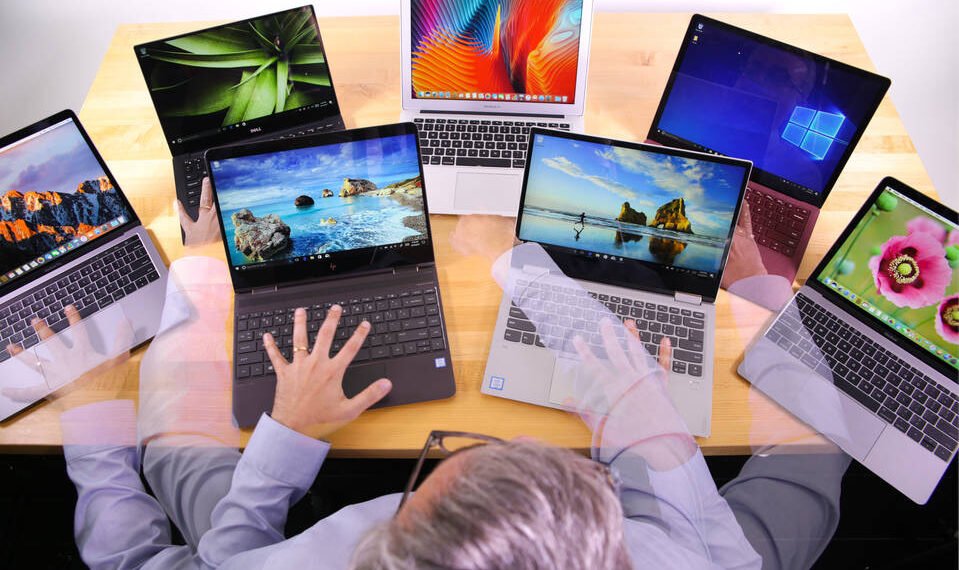Web designers rely on their laptops as essential tools for crafting digital experiences. A reliable laptop must easily handle the demands of coding, graphic design, and user interface tools while remaining fast and responsive. Without sufficient speed and power, tasks like editing high-resolution images or testing interactive layouts can become frustratingly slow.
Selecting the right laptop extends beyond performance—it involves considering display quality, multitasking capabilities, and the ability to run design software seamlessly. For professionals or beginners in web design, choosing the right device is crucial to staying productive and inspired during creative workflows.

Key Takeaways
- Choosing the right laptop ensures smooth web design workflows.
- Power and display quality are key for professional design tasks.
- A carefully selected laptop minimizes performance bottlenecks.
What Features Define a Great Laptop for Web Design?
Processor – The Core of Your Laptop
The processor dictates how well the laptop performs with design tools like Figma, Photoshop, or coding platforms. A strong CPU ensures faster loading, smoother multitasking, and efficient rendering. Entry-level users might consider models with an Intel Core i5 or AMD Ryzen 5, while advanced users should prioritize an Intel Core i7, Core i9, AMD Ryzen 7, or Ryzen 9 for optimal efficiency. For macOS users, the Apple M1, M2, or even newer chips are well-suited for creative professionals working on UI and UX designs.
Memory (RAM) – Essential for Multitasking
RAM defines how many tasks or programs your laptop can handle at once. A minimum of 8GB RAM is sufficient for light tasks, but web designers balancing apps like Photoshop, Visual Studio Code, or multiple browser tabs should aim for 16GB RAM. For intensive projects like animations or complex web interfaces, 32GB RAM or higher is recommended for consistent speed and zero lags.
Storage Options – The Divide Between SSD and HDD

A laptop’s storage type significantly impacts performance. SSDs (Solid State Drives) offer rapid boot times and faster file access, making them necessary for web design. Avoid older HDD options, as they are slower and outdated. For moderate users, a 256GB SSD might suffice, while professionals dealing with large assets like high-resolution images or videos should opt for 512GB or 1TB SSD storage.
| Type | Why Choose It? |
|---|---|
| HDD | Affordable but slow; avoid |
| SSD | Fast, reliable, a must-have |
The Display – Where Precision Counts
For web design, the display is one of the most important components. A 1080p display (Full HD) should be the minimum standard for clarity, but higher resolutions like 4K deliver better visual details. Look for a screen with wide color accuracy, such as 100% sRGB or AdobeRGB, to ensure your designs appear consistent across devices. A 15-16 inch screen size offers ample workspace without sacrificing portability.
Key Tip: Lightweight laptops with a high-resolution display, like the MacBook Pro or Dell XPS line, are widely favored by designers.
Graphics Card – Is It Necessary?
Most basic web design tasks like HTML and CSS don’t require a dedicated GPU. Integrated graphics, such as Intel Iris or those in Apple’s M-series chips, work perfectly for UI/UX design tools. However, if your projects include video editing, animations, or 3D rendering, a dedicated GPU like an NVIDIA RTX 4050 (or better) provides the extra power needed for smooth performance.
Weight and Battery – For Designers on the Move
Web designers working remotely or on the go need laptops that are lightweight and have long battery life. Devices weighing under 4 pounds are ideal for portability. Models like the MacBook Air or even select AMD Ryzen laptops cater to both portability and strong battery performance, often lasting 8 to 12 hours on a single charge. It’s also worth considering laptops with additional ports like USB-C and HDMI for greater flexibility in connectivity.
9 Best Laptops for Web Design – Expert Recommendations
1. Microsoft Surface Laptop 7 – 7th Generation Model

The Microsoft Surface Laptop 7 provides a combination of portability and power for web designers. It is equipped with a 12-core Snapdragon X Elite processor, ensuring reliable performance during complex design tasks. The 15-inch PixelSense Flow Touchscreen offers crisp visuals and smooth responsiveness, which enhance the user experience.
Strengths: Fast processing capability, responsive touchscreen, extended battery life.
Drawbacks: Limited ports require adapters, less suitable for gaming or intensive graphical workloads.
Best Fit: Students and professionals who prioritize portability and need a reliable device for design and general work.
2. Dell XPS 13 – Compact Edition with AI Copilot+

The Dell XPS 13 offers portability without sacrificing power, featuring Intel’s Core Ultra 7 processor with AI capabilities. Its 13.4-inch FHD+ screen has a 120Hz refresh rate, making scrolling and editing smooth and efficient. Designers appreciate its ultra-thin construction for ease of transport.
Strengths: AI-enhanced processor speeds up workflows, compact design, smooth visuals.
Drawbacks: Small screen might hinder detailed work, premium pricing limits accessibility for budget users.
Best Fit: Advanced designers who need portability and cutting-edge processing power for web design projects.
3. Apple MacBook Pro 14-inch – M4 Chip Version (2024)

Powered by the M4 chip, the MacBook Pro blends peak performance with energy efficiency. Its Liquid Retina XDR display delivers precise clarity and accurate color reproduction, essential for web design projects. The lightweight design completes its appeal to professionals.
Strengths: Industry-leading M4 processor, excellent display, long-lasting battery.
Drawbacks: High cost and need for extra adapters.
Best Fit: Professional designers seeking refined performance and seamless integration with Apple devices.
4. HP Updated 255 G10 – Full HD 15.6″ Build

The HP 255 G10 provides solid performance with its AMD Ryzen 7 processor and generous 64GB RAM. Its Full HD screen produces detailed visuals, while the numeric keypad supports task-specific workflows.
Strengths: Ideal multitasking support, large screen, additional keyboard features.
Drawbacks: Bulky design less suited for portability, shorter battery span.
Best Fit: Designers handling large files who prioritize power over portability.
5. KAIGERR 2025 Gaming Laptop – Budget-Friendly Option

The KAIGERR Gaming Laptop packs an Intel N150 processor, 16GB RAM, and a vibrant 15.6-inch IPS display into an affordable device. Though built for gaming, its hardware adapts well to web design applications.
Strengths: Robust specs, good color accuracy, affordable pricing.
Drawbacks: Heavier design, moderate battery performance during intensive use.
Best Fit: Designers on tight budgets who need strong computing power and don’t mind the weight.
6. ASUS ZenBook 14X – Compact OLED Wonder

The ASUS ZenBook 14X OLED combines stunning visuals and portability, with its 14-inch OLED display offering rich colors. Backed by Intel’s latest processors, it provides smooth and efficient functionality for design work.
Strengths: Vibrant OLED visuals, compact size, consistent performance.
Drawbacks: Limited connections, average battery life compared to competitors.
Best Fit: Designers valuing portability and high-quality visual displays.
7. Lenovo ThinkPad X1 Carbon – Durable Carbon Build

Known for its durability, the Lenovo ThinkPad X1 Carbon offers a sturdy yet lightweight design. Its 14-inch screen delivers accurate colors, essential for web design. Intel’s 13th Gen processors enable reliable multitasking and steady performance.
Strengths: Solid construction, excellent battery life, comfortable keyboard design.
Drawbacks: Integrated graphics may limit very high-end design software performance.
Best Fit: Professionals focused on portability and a dependable work experience.
8. Samsung Galaxy Book5 360 – Versatile AMOLED Design

The Samsung Galaxy Book5 360 combines a 2-in-1 design with vibrant AMOLED visuals on its 15-inch touchscreen. The 360-degree hinge accommodates multiple use cases, whether as a laptop or tablet, catering to flexible work styles.
Strengths: Brilliant display, hybrid functionality, lightweight appeal.
Drawbacks: Adapter dependence, midday charging requirements during heavy editing sessions.
Best Fit: Designers who value versatility and high-quality touchscreen displays for creating designs on the go.
9. ASUS ZenBook Pro Duo 15 – Dual-Screen Masterpiece

The ASUS ZenBook Pro Duo features innovative dual displays, including a 15.6-inch 4K OLED main screen and a secondary 4K ScreenPad Plus. Designers benefit from multitasking capabilities, pairing main workspaces with tools or references on the secondary display.
Strengths: Dual-screen efficiency, exceptional display quality, powerful hardware.
Drawbacks: Hefty frame, premium pricing.
Best Fit: Professionals handling demanding design applications who seek features tailored for productivity and multitasking.
How These 10 Laptops Were Selected for Web Design
When selecting laptops for web design, several practical factors were analyzed to ensure they meet the needs of modern designers. Performance was a top priority. Laptops with reliable processors like Intel Core i5/i7, AMD Ryzen 5/7, and Apple M1/M2 were chosen because they deliver the speed necessary for multitasking and running demanding design software like Figma or Adobe Photoshop.
Display quality played a major role as well. Each laptop was selected based on its ability to provide crisp visuals and accurate colors, ensuring that designs translate effectively across devices. This is critical for precision in UI and UX work.
Portability and battery life were also considered. Web design often requires flexibility, so lightweight laptops with long-lasting batteries were prioritized. These models allow designers to work comfortably without being tied to a power source.
Although web design doesn’t always demand high-end graphics capabilities, having solid graphics performance is still beneficial. Some selected laptops include dedicated GPUs that assist with animations, video editing, and rendering needs.
Lastly, price and value were carefully balanced. Options were included to cater to various budgets without compromising on essential features, ensuring designers get the most for their investment.
Wrapping Up
Selecting the right laptop simplifies web design tasks and enhances creativity. From sleek designs to high performance, there are excellent options tailored to both beginners and seasoned professionals. Prioritize features like display quality, powerful processors, and long-lasting battery life for a seamless experience. Whether for learning or advancing in the field, the perfect laptop supports designing with ease and precision, helping users focus on building stunning websites effectively.
Frequently Asked Questions

Which laptops are recommended for graphic design and web development in 2025?
Highly rated choices include the Dell XPS 15, known for its sharp display and performance, and the MacBook Air M2, which offers a sleek design and efficiency. The ASUS ZenBook Pro Duo, offering dual screens, is also popular among professionals. Learn more about laptops suitable for web design.
What key features should a laptop have for web design and development?
A capable CPU, such as an Intel Core i5 or AMD Ryzen 5, supports smooth operations. At least 16GB of RAM ensures multitasking efficiency, while an SSD with fast read/write speeds improves load times. Details about choosing the best configuration are available here.
Is it possible to use an affordable laptop for professional web and graphic design tasks?
Budget laptops can work efficiently if they meet minimum requirements like 8GB RAM and an updated processor. However, professionals often prefer higher-end models with improved GPUs for advanced design tasks. Discover more insights on affordable options.

How much memory is ideal for both web design and multitasking?
For efficient multitasking, 16GB of RAM is commonly recommended. However, for large projects or multiple design tools, 32GB may be more reliable, especially when working with graphics-heavy applications.
What do developers typically prioritize when choosing a laptop for coding and web design?
Developers look for laptops with strong keyboard ergonomics for prolonged coding sessions, low-latency display panels, and robust battery life. Good examples include devices like the Lenovo ThinkPad X1 Carbon, which combines portability and comfort. Explore more recommendations for coding laptops.
Are certain laptops specially designed for photo editing and other graphic-heavy tasks?
Laptops such as the MacBook Pro M4 with its high-resolution display and efficient processor are tailored for these tasks. Models with dedicated GPUs, like the Dell XPS 15, are similarly well-suited for graphic-intensive work. Learn about graphic design laptops.






































Comments 1